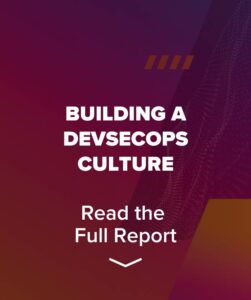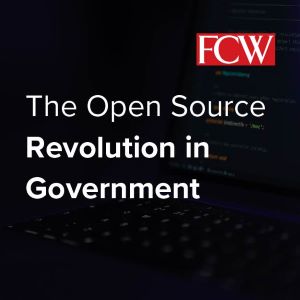As software becomes more sophisticated, it plays an increasingly important role in all aspects of government operations. However, given the complexity and intertwined nature of modern software, any vulnerability could have wide-ranging consequences, which makes security of vital importance. The federal government has taken notice. A number of recent policy directives address issues related to the software supply chain, and key agencies are leading a governmentwide effort to promote secure software development, including the Executive Order on Transforming Federal Customer Experience and Service Delivery to Rebuild Trust and the Executive Order on Improving the Nation’s Cybersecurity. Learn how you can implement DevSecOps to support your journey to secure, innovative software in Carahsoft’s Innovation in Government® report.
The Mindset Shift that Enables DevSecOps
“In an ideal world, technology and processes support team members’ ability to deliver on their particular talents. Before agencies implement DevSecOps methodologies, they should identify where their processes are getting bottlenecked and forcing people to either work around them or fundamentally change their behavior. Instead, we want to make it easy for employees to do the right thing. The goal is to enable people to focus on what they do best — regardless of where they operate in the stack or the tools they are using — so that agencies can build and deploy secure, modern apps.”
Read more insights from Alex Barbato, Public Sector Solutions Engineer at VMware.
How Generative AI Improves Software Security
 “Generative AI tools are becoming increasingly prevalent, providing interactive experiences that captivate the public’s imagination. These tools are accessible to anyone, offering a unique opportunity to engage and explore the creative possibilities enabled by AI technology. The technology doesn’t just train a model to recognize patterns. It can create things that are easy to understand: images, text, even videos. Sometimes the results are hilariously wrong, but other times the results are quite impressive, such as clear, concise answers to complex questions. Generative pre-trained transformer (GPT) technology, such as ChatGPT, has opened the doors for everyone to be an evaluator because the output is accessible and easy to critique.”
“Generative AI tools are becoming increasingly prevalent, providing interactive experiences that captivate the public’s imagination. These tools are accessible to anyone, offering a unique opportunity to engage and explore the creative possibilities enabled by AI technology. The technology doesn’t just train a model to recognize patterns. It can create things that are easy to understand: images, text, even videos. Sometimes the results are hilariously wrong, but other times the results are quite impressive, such as clear, concise answers to complex questions. Generative pre-trained transformer (GPT) technology, such as ChatGPT, has opened the doors for everyone to be an evaluator because the output is accessible and easy to critique.”
Read more insights from Robert Larkin, Senior Solutions Architect at Veracode.
Open Source is at the Heart of Software Innovation
“Embedding security into applications from the start is essential for streamlining and strengthening the entire development life cycle. Securing the software supply chain is a related effort that is of vast importance to government operations. Beyond securing individual applications, the ultimate goal is to build security into the pipeline itself. At each step and every handoff, we must be able to verify who has touched the software and who did what to ensure that the end result is what we intended to build and that nothing malicious has been injected along the way.”
Read more insights from Chris Mays, Staff Specialist Solutions Architect at Red Hat.
DevSecOps Needs Tool Diversity and Collaboration
“As DevSecOps methodologies and software factories grow in prevalence, agencies are recognizing that software development is a team sport — inside the agency, across departments and with external stakeholders. It touches many different teams, but getting everyone on the same page with tooling can be difficult. Different teams prefer different tools, and that makes collaboration hard. Modern software development brings security practices forward in the timeline while reducing duplication of efforts and improving real-time accountability. Success hinges on removing blockers, creating visibility and making sure collaboration is happening at every stage. In addition, encouraging input from different areas of the organization from the beginning and throughout development is vital for innovation.”
Read more insights from Ben Straub, Head of Public Sector at Atlassian.
Observability Speeds Zero Trust and Application Security
“In response to increasing cyberthreats, the government is speeding up the move to zero trust. This security model assumes that every user, request, application and non-human entity is not to be trusted until its identity can be verified. Zero trust principles require a layered defense that is more effective when rooted in observability. To develop an architecture that validates and revalidates every entity on the network, it is necessary to know what those entities are, how they’re communicating and how they typically behave so we can recognize deviations. Zero trust and observability technologies work together to create a more secure and resilient network environment by assuming that all requests for access are untrusted and continuously monitoring the network to detect and respond to potential threats.”
Read more insights from Willie Hicks, Public Sector Chief Technologist at Dynatrace.
The Role of a Service Mesh in Zero Trust Success
“For large companies and government agencies, it’s safe to assume that a committed attacker is already inside their networks. Executive Order 14028 mandates that every federal agency develop a Zero Trust architecture because it is the most effective approach to mitigating what attackers can do once they’ve made their way inside. What does Zero Trust look like at runtime? One of the key considerations is identity-based segmentation, which involves conducting five policy checks for every request in the system: encrypted connection between service endpoints, service authentication, service-to-service authorization, end user authentication, and end user-to-resource authorization.”
Read more insights from Zack Butcher, Founding Engineer at Tetrate and co-author of the NIST SP 800-200 series and SP 800-207A.
AI and the Journey to Secure Software Development
“By automating and optimizing DevSecOps workflows, we can still shift security left while relieving developers from the burden of some complex remediation. It begins with a workflow that leverages fully automated security scanning to rapidly identify vulnerabilities as well as providing suggested remediation for vulnerabilities and on-demand remediation training to educate developers on what they are getting into. The rapid evolution of artificial intelligence is making new advances possible. The opportunities go well beyond AI-assisted code creation. AI features are being expanded across the entire software development life cycle. When it comes to security, having AI assist by making code functionality clear or explaining a vulnerability in detail reduces the time required to remediate risk.”
Read more insights from Joel Krooswyk, Federal CTO at GitLab.
Scaling App Development While Meeting Security Standards
“The dream for any software development team is constant, stable releases. The faster teams get the work they’ve created into production, the faster the agency can derive value from that work. When app development is stymied by cumbersome security reviews and stability testing and by the need to wait for a deployment window, innovation is stifled and the return on investment is delayed. If agencies want to have efficient, value-driving software development teams, those teams must be able to move with agility. A trustworthy, scalable DevOps pipeline that brings together testing and security in a seamless way allows teams to push out new apps and improvements quickly so government employees and citizens can have a seamless digital experience and the most up-to-date tools and information.”
Read more insights from Kyle Tobener, Head of Security and IT at Copado.
Join us in-person for our must-attend DevSecOps Conference—an exciting day of exhibits, speaking sessions, and networking events. We look forward to showcasing new DevSecOps updates from our supporting panels featuring government, systems integrators, and industry thought leaders.
Download the full Innovation in Government® report for more insights from DevSecOps thought leaders and additional industry research from FCW.

 “Open source transforms the way agencies manage hybrid and multi-cloud environments. The most critical technology in the cloud, across all providers, is Linux. Everything is built on top of that foundation — both the infrastructure of the cloud and cloud offerings. Given the right partner, the promise of Linux is that it provides a consistent technology layer for agencies across all footprints, including multiple cloud providers, on-premises data centers and edge environments. From that foundation, agencies and their partners can build portable architectures that leverage other open source technologies. Portability gives organizations the ability to use the same architectures, underlying technologies, monitoring and security solutions, and human skills to manage mission-critical capabilities across all footprints.”
“Open source transforms the way agencies manage hybrid and multi-cloud environments. The most critical technology in the cloud, across all providers, is Linux. Everything is built on top of that foundation — both the infrastructure of the cloud and cloud offerings. Given the right partner, the promise of Linux is that it provides a consistent technology layer for agencies across all footprints, including multiple cloud providers, on-premises data centers and edge environments. From that foundation, agencies and their partners can build portable architectures that leverage other open source technologies. Portability gives organizations the ability to use the same architectures, underlying technologies, monitoring and security solutions, and human skills to manage mission-critical capabilities across all footprints.” How to Move DevOps from Disarray to Unity
How to Move DevOps from Disarray to Unity